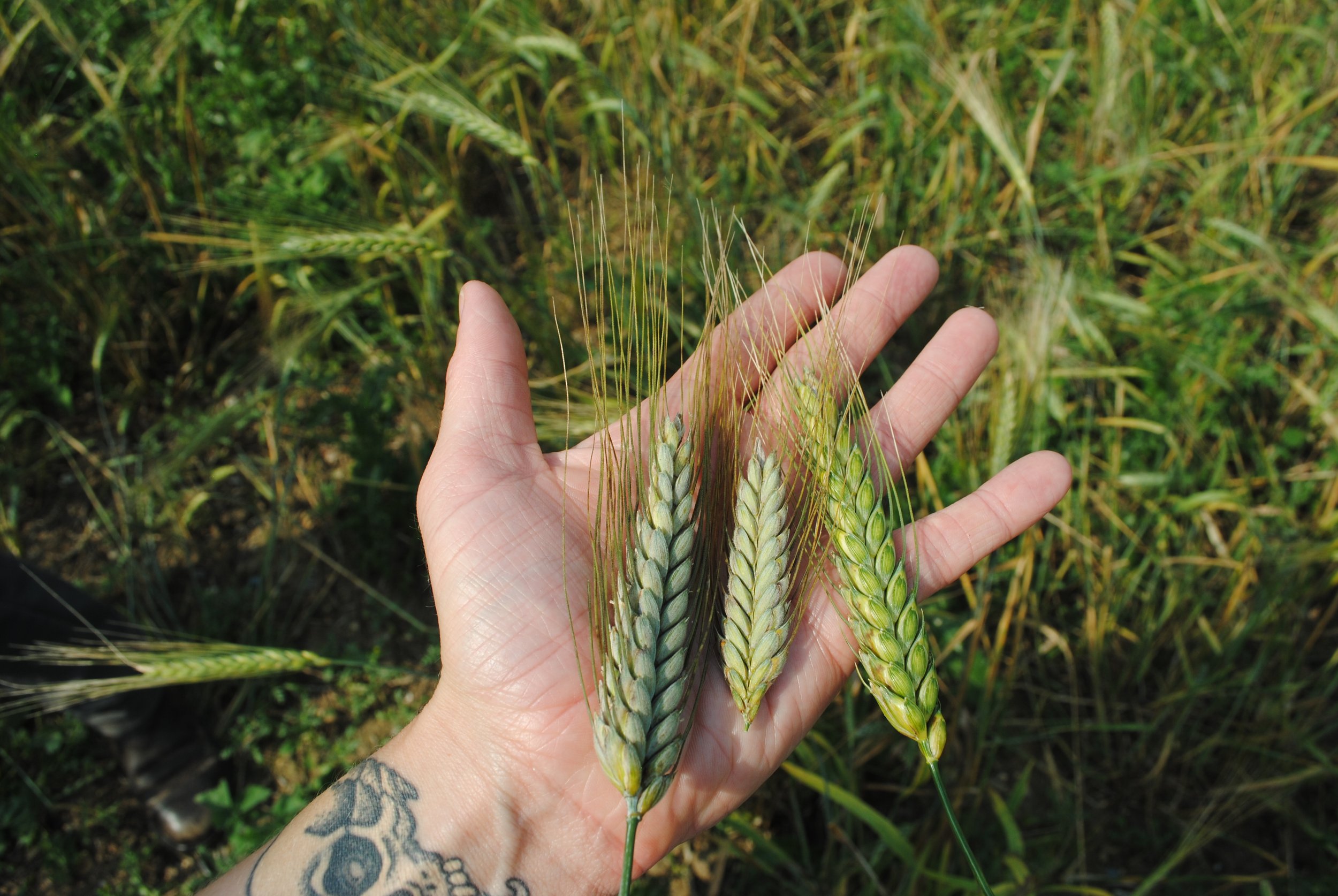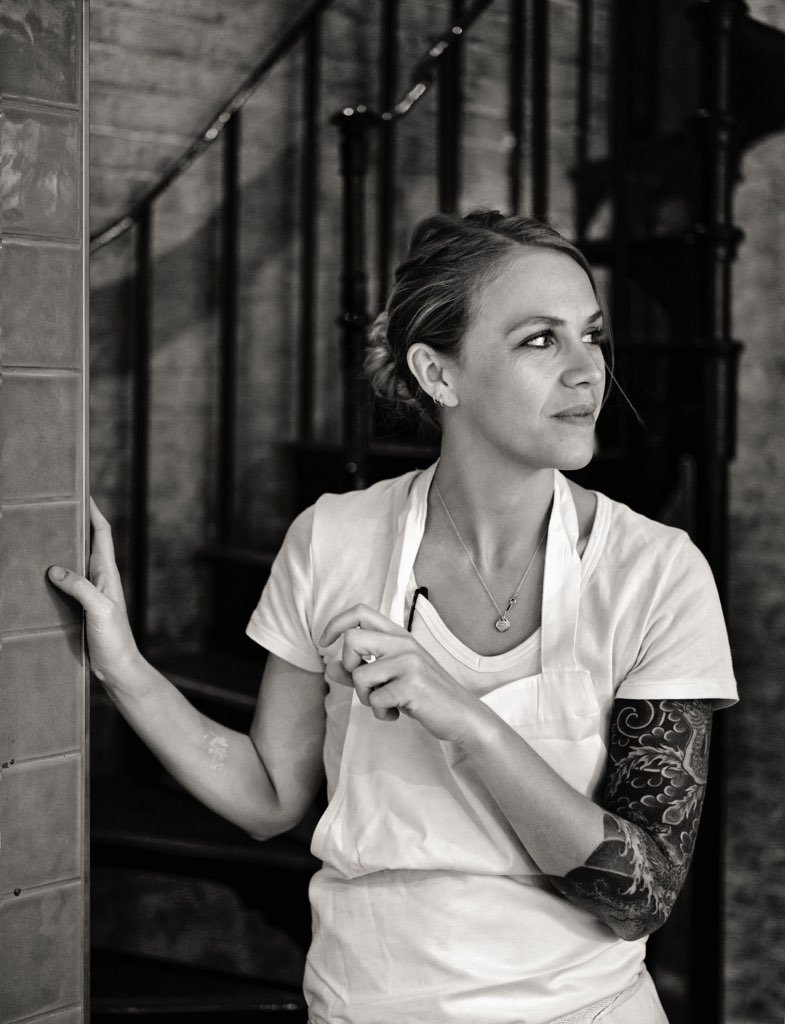Why Wheat Matters
Like all aspects of modern life, industrial farming has become very focused on efficiency: chasing higher productivity and maximum profits. The changes introduced over the last 30 years to the way we farm wheat have achieved these efficiency-focused goals. They’ve created more reliable homogenised crops that create reliable homogenised products. But, in chasing consistency, we have created a wide raft of other issues that we’re only coming to understand and deal with.
Helen Evans, head of bread and pastry at the inimitable Flor Bakery, London explores what a focus on reliable wheat has done to our fields and loaves. She explains why she’s pushing for more traditional farming methods and why we should all care more about the flour in our bread.
Helen Evans at Flor Bakery, London.
Imagine large-scale agriculture; think rolling fields of wheat and enormous combine harvesters churning high yield at high speed. The wheat these huge machines are harvesting will undoubtedly be a modern wheat, a crop that has been “dwarfed” intentionally (bred to grow shorter and more uniformly) to make yield consistent and by-product low. These dwarfed varieties of modern wheat, introduced during the Green Revolution, have been adapted over the years to appeal to a consumer's taste for white, light, fluffy bread; they create an open crumb, aka the big holes inside a loaf that your butter melts through beautifully. This kind of wheat is reliable and consistent, not only in yield for the farmer but also in its usability in the bakehouse. Writing as a baker who uses the best part of a tonne of flour a week, (to make around 2000 loaves) being able to rely on your flour when you use little else except salt and water, provides welcome relief to an already stressful job.
However, this reliability and consistency come at a price. Consider that only a handful of seed companies control most of the agricultural market. Not only do they sell the seed to the farmer, but they also supply the pesticides to ensure high yielding fields. Pesticides and fertilisers do soil no good whatsoever; they contribute to greenhouse gas emissions and a decrease in biodiversity.
So what if we decide that big holes and open crumb structures aren’t so important to us? What if we could use fewer pesticides to ensure we’re creating healthier soil for future generations?
Well, here at Flor, we are committed to using heritage wheat or “long-straw” varieties, which may not be as strong and reliable as their modern counterparts, but they do something much more important: they grow well in systems that don’t need so many pesticides and therefore can actively promote soil health.
Take Red Lammas as one of the oldest long-straw varieties (first recorded in 1660). It grows much taller in the field. Therefore, its roots travel deeper, meaning it’s better equipped to scavenge the nutrients it needs to grow and prosper directly from the soil, negating the need for commercial fertiliser. Because it grows taller, it’s also much better at naturally suppressing the weeds that try to compete with it, negating the need for commercial pesticides, too (the very pesticides that the seed companies are flogging alongside their “strong modern wheat” seeds).
By encouraging the use of long-straw or pre-Green Revolution wheat and thereby discouraging the use of fertilisers and weed killers, we can essentially let nature grow as intended, giving it back its resilience in diversity. This, in turn, helps the soil build back ITS natural resilience too, which is vital if we want to be able to count on it for any future harvests.
As consumers, we can also make a difference, for example, we could all be a little more curious – get to know your local baker and ask what kind of wheat they're using in their bread. Look for bakeries working with farmers that support regenerative agriculture. Consumers need to stop seeing wheat as just a 'commodity' - we need to start thinking more about where it's coming from. In the same way, we’re encouraged to ask, “Who made my clothes?” we should be asking, “Who made my bread?”
If you don't know where the wheat in your loaf of bread comes from, you're supporting the commodity system. In basic terms, the commodity system = disempowered farmers, centralised farming, monoculture, a lack of diversity and a greater reliance on inputs (that destroy soil health).
For the home bread-makers, I suggest buying flour from the likes of Hodmedods and Gilchester's – both of which usually stock a good selection of heritage and other kinds of wheat grown under low-input systems.
At Flor, we work directly with farmers and maintain an open and transparent dialogue about our wheat and how it’s grown, ensuring a more active participation in the supply chain. Instead of simply making demands on the farmer and his/her farmland, we ask what the land can provide us, then implement our skills as bakers to transform its provisions into something really tasty.
Many of our farmers are using smart techniques to farm more regeneratively; for example, undersowing crops with clover or growing legumes to fix nitrogen naturally in the soil (nitrogen is necessary for building protein in wheat and is, therefore, a component in artificial fertiliser). Without enough nitrogen, plants and microbes cannot effectively sequester carbon in the soil in the first place. Clover is actually very palatable for livestock and so is often sown as part of a herbal ley or cover crop destined for cattle grazing – integrating livestock is another great way to increase organic carbon in the soil.
“Instead of simply making demands on the farmer and his/her farmland, we ask what the land can provide us, then implement our skills as bakers to transform its provisions into something really tasty. ”
Most of our farmers also implement the “no-till” approach: leaving the roots of crops undisturbed by mechanical agitation, thereby reducing soil disturbance. These are just some of the low-input systems we like to see our wheat growing in and hopefully contributing to as well.
Sometimes these heritage grains are more challenging to work with (less consistent, lower in gluten and therefore strength), so we adapt our recipes as the flour changes season to season. Some of our loaves are naturally a little denser or the crumb a little tighter due to the lower strength of the flour, but that also means you get more flavour per mouthful, right?! Each type of wheat varies in its functionality and flavour, meaning our products have character and inconsistencies. In a way, this is a perfect parallel with the diversity and inconsistencies we like to see in the fields: wheat growing as nature intended and not in perfectly uniform rows in a monoculture environment.





